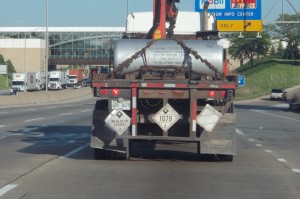Often I get questions from people who are not customers. Though perhaps they will be customers in the future.
Hello
I came across your website and found the content to be very informative. I do have 1 question about bulk packages (I assume he read my blog article about Bulk Packaging for HazMat transportation). Can you further define the 3rd part of the bulk package definition? (3) A water capacity greater than 454 kg (1000 pounds) as a receptacle for a gas as defined in §173.115 of this subchapter.
Isn’t that a 119 gallon container? But how does that relate to gas?
Thanks for your time
My reply that same day:
That’s a really good question and one I struggled with when a customer of mine wanted to know the proper methods for shipment of compressed gas cylinders of Oxygen. Here is what I know about bulk packaging for a gas from researching the regulations and speaking with PHMSA/USDOT:
- It applies to a gas as defined at 49 CFR 173.115, which includes the following:
- Division 2.1 (Flammable gas)
- Division 2.2 (non-flammable, nonpoisonous compressed gas—including compressed gas, liquefied gas, pressurized cryogenic gas, compressed gas in solution, asphyxiant gas and oxidizing gas)
- Division 2.3 (Gas poisonous by inhalation)
- Non-liquefied compressed gas
- Liquefied compressed gas
- Compressed gas in solution
- Cryogenic liquid
- Refrigerant gas or Dispersant gas
- Adsorbed gas
- The threshold amount for a gas (>454 kg or 1,000 pounds water capacity) is based on an estimated density of water of 8.403 lb/gal: 119 gal x 8.403 lb/gal = >1,000 lbs water capacity.
- You are correct that a bulk packaging for a gas (as defined at 49 CFR 173.115) has a maximum capacity of >119 gallons – the same as for a liquid.
- The definition of a bulk packaging for a solid also includes a threshold amount of >119 gallons, so clearly, this is a value used uniformly throughout the definition of a bulk packaging no matter the phase of the HazMat (liquid, solid, or gas).
 I hope this helps. Please don’t hesitate to contact me with any questions.
I hope this helps. Please don’t hesitate to contact me with any questions.
His reply of gratitude and a good observation.
Daniel
Thanks for the quick response.
There is so much info out there so if you don’t travel with bulk quantities of material everyday it is tough to be sure we are in compliance.
Now I had a question for him.
Thank you for your cooperation.
One more thing, you may know this better than I, but I understand that it is unlikely to find a USDOT-approved compressed gas cylinder that meets the definition of a bulk packaging. Most gases if transported in a bulk packaging will either be in a cargo tank or portable tank. Is that your understanding as well?
Thank you and please advise.
Dan
And now he gave me some good advice.
Based on presentations and interaction with DOT enforcement offices and State Troopers, I believe you are correct. They mentioned something about older bulk containers being grandfathered in to the newest rules (like propane trucks?).
I didn’t pay much attention to it because we typically don’t get into it in our business. I have been told by our Mechanical Department that the 1 bulk compressed gas package we use is acceptable as long as we have a CDL holder with haz mat and bulk endorsements and the shipping papers/manifest to go with it.
I get the impression that the rules are interpreted differently from officer to officer too. There is just too much for 1 person to be an expert on.
I was grateful for his information and had an observation of my own.
While your Mechanical Department may be right, the packaging still must be authorized for the HazMat per column 8 of the Hazardous Materials Table and meet either the USDOT specifications for a compressed gas cylinder or the UN specifications for a pressure receptacle. Or, it could be subject to a Special Permit in which case neither may be necessary.
You are correct that it can be very confusing and you can hear different opinions from different people. That is why I always rely solely on the regulations and not what people tell me. If someone tells you something regarding compliance, they should be able to back it up by citing the applicable regulation.
Please don’t hesitate to contact me if you have any questions.
Dan
Contact me with any questions you may have about the transportation of hazardous materials by air, highway, vessel, or rail International and Domestic Daniels Training Services 815.821.1550 |
